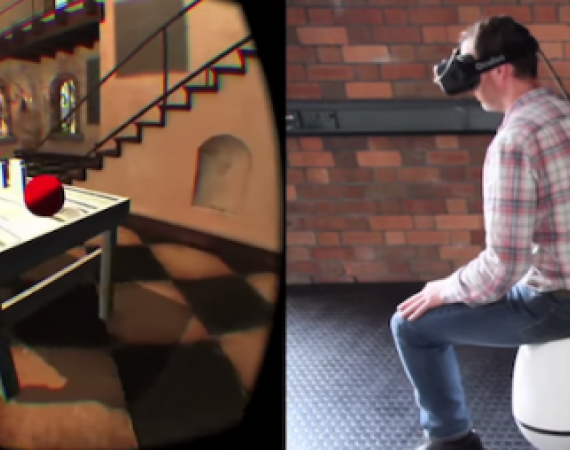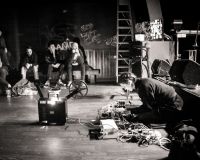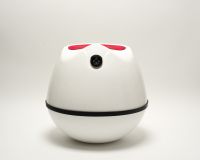Lunchtime talk write-up
Posted on Tue 26 May 2015
How do we take a stroll in virtual reality?
Studio resident Joe Ryan recently gave a lunchtime talk about issues of mobility in VR and the different ways that people are trying to get around them. As well as explaining the developments of the wider VR community, for the first time, he shared information about his new R&D project, VRGo.

Joe Ryan demoing the VRgo Chair
Posted by

Jasmine Butt
Jasmine is a musician, synth builder and AV artist who is currently exploring modular synthesis.Speaker

Joe Ryan
Joe Ryan, founder and director of VRGO, is working on a new kind of movement controller that he hopes will resolve some of the common problems related to locomotion in VR.Virtual Reality is one of the most rapidly developing industries in the technology sector, but before it can develop much further, a few issues need to be ironed out. Studio resident Joe Ryan recently gave a lunchtime talk about issues of mobility in VR and the different ways that people are trying to get around them. As well as explaining the developments of the wider VR community, for the first time, he shared information about his new R&D project, VRgo.
VR - Virtual Reality technology is developed to stimulate a feeling of presence in a virtual world. The main piece of kit is usually head-mounted, and uses motion sensors and stereoscopic images to allow people to look around a 3D virtual space. Since Oculus Rift’s Kickstarter success in August 2012 (where they secured almost 10 times their initial requested amount of $250,000) the industry has boomed. All over the world, tech companies huge and small are experimenting with sensors to stimulate the feeling of presence in a virtual world, both in terms of mobility and gesture tracking.
The History - To give us a bit of context, Joe took us through a brief history of VR. Before 2012, experiments with virtual reality were seldom successful. VR as we know it was first explored by the military, who built the first head-mounted displays for flight simulation training in the 70s. Games companies like Sega and Nintendo began exploring VR in the 80s, and Nintendo launched the Virtual Boy in the 90s, which was a total flop due to its price, lack of portability and the eye-strain and headaches that players suffered due to the crude graphics of the time.
Current VR hardware - Joe showed us a ‘VR hardware radar’, and drew our attention to the current products on the market, which address locomotion. There have been lots of experiments exploring ways to enable people to physically and intuitively control movement in a virtual world without actually walking around a room. It is useful to encourage physical movement rather than just introducing a handheld controller, as players can experience ‘sim sickness’ when movement in the physical and virtual worlds don’t correlate. Joe showed us some videos of recent VR mobility experiments, including the Virtual Sphere (a giant hamster ball), the Infinadeck (a 360° treadmill) the Omni (a non-friction walk mat), and the ROTO chair (a motorised swivel chair). A lot of these are described as affordable and revolutionary, but are still large pieces of kit, and very expensive to own.
The beginnings of VRgo - Joe shared the story of how he first came up with the idea for the VRgo. A couple of years ago, Joe was on a furniture-making course. He was suffering from some back trouble, and decided to design and build a self-righting stool to help to improve his posture and strengthen his back. He built the stool by hand, out of jigsaw-cut, hand sanded MDF. Shortly after this, Joe worked on Dance Tag, a NESTA project developing a geo-locative dance-sharing app. The project introduced Joe to a community of creative technologists, and sparked an idea; perhaps he could use motion sensors to turn his self-righting stool into a game controller... He built some gyroscopes and accelerometers into the stool and tested it out. It worked really well; the stool swivels and tilts really easily, and these two motions can control both direction and acceleration. They are also exploring the possibility of developing their own sensor module.
Have a look at this video of Joe playing with the VRgo to get a sense of how it works:
Follow @vrgochair for project updates and user testing sessions.